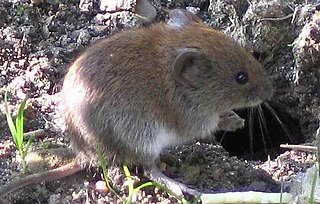
The Arvicolinae are a subfamily of rodents that includes the voles, lemmings, and muskrats. They are most closely related to the other subfamilies in the Cricetidae. Some authorities place the subfamily Arvicolinae in the family Muridae along with all other members of the superfamily Muroidea. Some refer to the subfamily as the Microtinae or rank the taxon as a full family, the Arvicolidae.

The rock vole is a medium-sized vole found in eastern North America. It is also called the yellow-nosed vole.

Red-cheeked squirrels are species of squirrels in the genus Dremomys in the subfamily Callosciurinae. The six species which are all found only in Asia are listed as "Least Concern" by the IUCN.

The white-spined Atlantic spiny rat is a spiny rat species endemic to Brazil.
Pratt's vole is a species of rodent in the family Cricetidae. It is endemic to Mount Emei, Sichuan, China. It was named in 1891 for Antwerp Edgar Pratt.

Eothenomys is a genus of rodent in the family Cricetidae. It contains the following species:
The Southwest China vole is a species of rodent in the family Cricetidae. It is found only in Yunnan and Sichuan, China. It occurs in Cangshan Erhai Nature Reserve.
The Ganzu vole, Eva's red-backed vole, Eva's vole, Gansu vole, or Taozhou vole is a species of rodent in the family Cricetidae. It is found in mountain forests in China. The IUCN has assessed it as being of "least concern".

Père David's vole is a species of rodent in the family Cricetidae. It is found in China, Myanmar, Taiwan, and Thailand. This species is a member of the melanogaster group, one of the two main groups of Eothenomys voles. Its dorsal pelage is dark brown, often nearly black, and the ventral pelage is gray, sometimes brown. The tail is shorter than the body. This species is found in pine/rhododendron forests.
The Chaotung vole is a species of rodent in the family Cricetidae. It is found only in Yunnan, Sichuan, and Guizhou, China.
The Yulungshan vole, Yulong Chinese vole, Yulongxuen Chinese vole, or Yulongxuen red-backed vole is a species of rodent in the family Cricetidae, endemic to Jade Dragon Snow Mountain in the Sichuan–Yunnan border region of China.
The Shansei vole is a species of rodent in the family Cricetidae. It is found only in north-central China where its habitat is forests.

The fawn-footed mosaic-tailed rat, or fawn-footed melomys is a species of rodent in the family Muridae. It is found along eastern coastal regions of Australia.
Boehm's gerbil is a species of rodent found in Angola, Burundi, Democratic Republic of the Congo, Kenya, Malawi, Mozambique, Rwanda, Tanzania, Uganda, and Zambia. Its natural habitats are dry savanna, moist savanna, and arable land. This is a common species with a wide distribution which faces no obvious threats, so in 2004 the International Union for Conservation of Nature rated its conservation status as being of "least concern".

The Myodini are a tribe of forest voles in the subfamily Arvicolinae. Species in this tribe are:
The Yunnan red-backed vole is a species of rodent in the family Cricetidae. It is found in Southwest China, specifically Yunnan Province. It is the largest member of the genus Eothenomys, with a higher cranium, a soft, thick and long coat with tawny brown to reddish brown coloring and grey underparts.
The Ward's red-backed vole is a species of rodent in the family Cricetidae. It is found in China, specifically the north-western area of Yunnan Province. It is sometimes considered a subspecies of Eothenomys chinensis, but most zoologists consider it to be a separate species due to the noticeably shorter tail and hind feet.

The red serow, also called the Burmese red serow is a goat-antelope thought to be native to southern Bangladesh and northern Myanmar. It has been sometimes been considered a subspecies of C. sumatraensis. In the northeastern part of India, the red serow occurs widely in the hills south of the Brahmaputra river. although the IUCN states that this species is recorded with certainty only from Myanmar, in Kachin State, and that records in India refer to the Himalayan serow.
The long-nosed paramelomys is a species of rodent of the family Muridae endemic to New Guinea. It is found in the lowlands of the south of the country.









